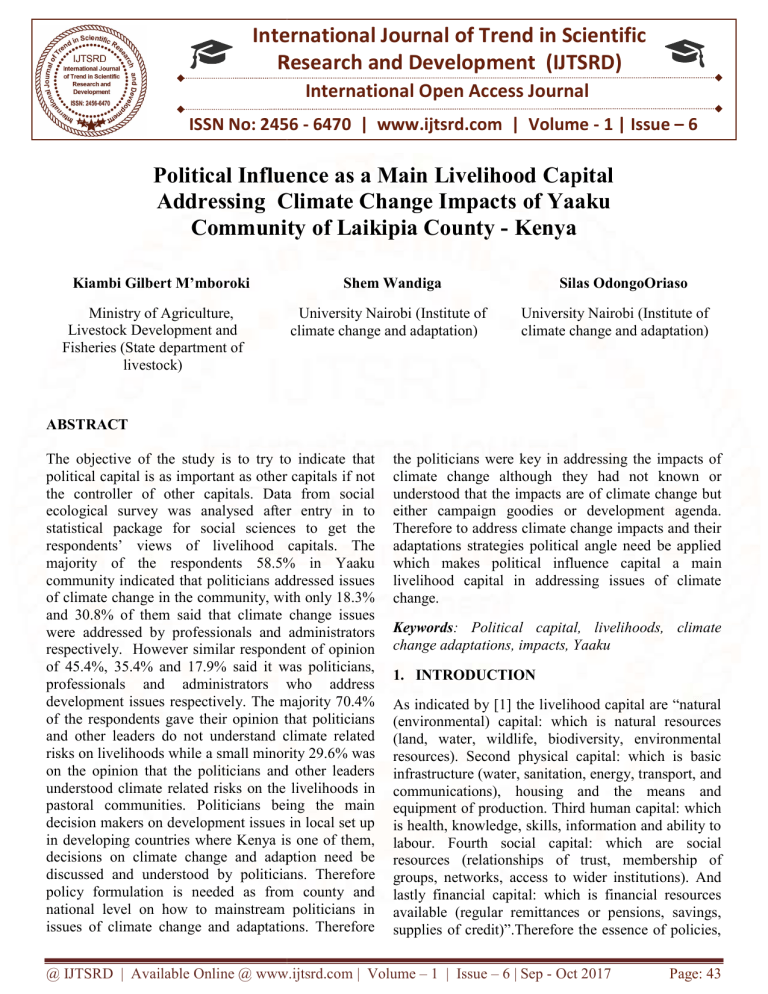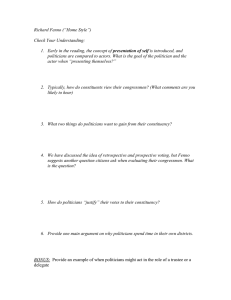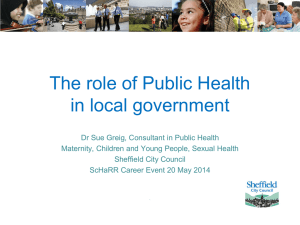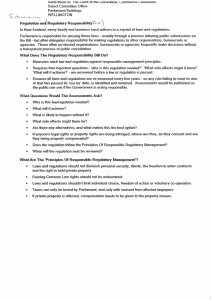
International Journal of Trend in Scientific
Research and Development (IJTSRD)
International Open Access Journal
ISSN No: 2456 - 6470 | www.ijtsrd.com | Volume - 1 | Issue – 6
Political Influence as a Main Livelihood Capital
Addressing Climate Change Impacts off Yaaku
Community of Laikipia County - Kenya
Kiambi Gilbert M’mboroki
Ministry of Agriculture,
Livestock Development and
Fisheries (State department of
livestock)
Shem Wandiga
University Nairobi (Institute of
climate change and adaptation)
Silas OdongoOriaso
University Nairobi (Institute of
climate change and adaptation)
ABSTRACT
The objective of the study is to try to indicate that
political capital is as important as other capitals if not
the controller of other capitals. Data from social
ecological survey was analysed after entry in to
statistical package for social sciences to get the
respondents’ views of livelihood capitals. The
majority of the respondents 58.5% in Yaaku
community indicated that politicians addressed issues
of climate change in the community, with only 18.3%
and 30.8% of them said that climate change issues
were addressed by professionals and administrators
respectively. However similar respondent of opinion
of 45.4%, 35.4% and 17.9% said it was politicians,
professionals and administrators who address
development issues respectively. The majority 70.4%
of the respondents
spondents gave their opinion that politicians
and other leaders do not understand climate related
risks on livelihoods while a small minority 29.6% was
on the opinion that the politicians and other leaders
understood climate related risks on the livelihood
livelihoods in
pastoral communities. Politicians being the main
decision makers on development issues in local set up
in developing countries where Kenya is one of them,
decisions on climate change and adaption need be
discussed and understood by politicians. Theref
Therefore
policy formulation is needed as from county and
national level on how to mainstream politicians in
issues of climate change and adaptations. Therefore
the politicians were key in addressing the impacts of
climate change although they had not known or
understood that the impacts are of climate change but
either campaign goodies or development agenda.
Therefore to address climate change impacts and their
adaptations strategies political angle need be applied
which makes political influence capital a main
mai
livelihood capital in addressing issues of climate
change.
Keywords:: Political capital, livelihoods, climate
change adaptations, impacts, Yaaku
1. INTRODUCTION
As indicated by [1] the livelihood capital are “natural
(environmental) capital: which is natural resources
(land, water, wildlife, biodiversity, environmental
resources). Second physical capital: which is basic
infrastructure (water, sanitation, energy, transport,
t
and
communications), housing and the means and
equipment of production. Third human capital: which
is health, knowledge, skills, information and ability to
labour. Fourth social capital: which are social
resources (relationships of trust, membership
members
of
groups, networks, access to wider institutions). And
lastly financial capital: which is financial resources
available (regular remittances or pensions, savings,
supplies of credit)”.Therefore the essence of policies,
@ IJTSRD | Available Online @ www.ijtsrd.com | Volume – 1 | Issue – 6 | Sep - Oct 2017
Page: 43
International Journal of Trend in Scientific Research and Development (IJTSRD) ISSN: 2456-6470
processes and institutions cannot be overemphasized,
because they engage at all levels, from the family to
the international arena, and in all spheres, from the
most public to the most private[2]. They in a big way
determine access (to various types of capital, to
decision-making bodies to source of influence and
livelihood strategies), returns to any given livelihood
strategy and terms of exchange between different
types of capitals [2]. Whether people are able to
achieve a feeling of inclusion and well-being, there is
a direct impact on policies, institutions and processes.
Because culture is inclusive in this area they also
account for other ‘unexplained’ variability in the ‘way
things are done’ in different societies [2]. Decision
making processes and access to assets can be greatly
determined by policies, institutions and processes.
The policies, institutions and processes are here
referred to as political influence or capital. Figure 1
below shows the mukogodo East ward where Yaaku
community resides in mukogodo forest.
Figure 1: A map of Laikipia County showing the mukogodo East Ward
Methodology
The study population comprised of 800 households in
Mukogodo and Sieku locations in Mukogodo East
ward while the sampling frame, from which the study
sample was drawn constituted all the households
living in the nine villages of these two locations. The
unit of analysis was the household and the subject of
analysis (the respondent) was the head of the
household or their representative.
In each of the nine villages, a list of the households
was compiled during the process of community
managed disaster and risk reduction (CMDRR) as
used by[3], [4], [5], and systematic sampling was used
to pick numbers of households (actually about 30
percent of households) from each village[6]. Then
random sampling was undertaken among the
systematically selected households in each village, to
constitute a study sample of 240 households.
Two formulae from [8], and [7] were used for
computing the study sample size, but yielded rather
large sample sizes that could not be sustained by the
available resources for the study. According to [7], a
minimum of 100 is recommended for a survey
research and gives a reasonable unit for analysis.
@ IJTSRD | Available Online @ www.ijtsrd.com | Volume – 1 | Issue – 6 | Sep - Oct 2017
Page: 44
International Journal of Trend in Scientific Research and Developm
Development
ent (IJTSRD) ISSN: 2456-6470
2456
[6] Indicated that at least 30% of the total population
is representative. Thus, 30%
% of the accessible
population is enough for the sample size. Thus in this
study 30% of 800 households was (240) respondents.
1986 to 2015. Data from social ecological
ecol
survey was
analysed after entry in to Statistical Package for
Social Sciences to get the respondents’ views of land
use and management within the three decades.
Hence resorting
ng to the provisions of the Statistical
Package for the Social Sciences programme, which
suggest that any sample size of 200 and above will
allow perfect functioning of all the analytical
procedures provided by the programme.
Results and discussions
A socio-ecological survey usingg a structured
questionnaire was used to collect respondent’s
opinion on climate changes and adaptation on land
use and management in specific based on livelihood
capitals (social capital) for last three decades as from
100%
45.6%
54.4%
60.4%
Changes in trends in Member of Parliament influence
for last three decades
Figure 2 changes in trend in Member of Parliament
influence.
94.2%
97.7%
5.8%
2.3%
39.6%
0%
decreasing
increasing
members of members of members of members of
the
the
the
the
parliament parliament parliament parliament
influence
influence 10 influence 20 influence 30
now
years ago
years ago
years ago
Figure 2: Changes in trends in Member of Parliament influence the last three decades
As indicated by Figure
igure 2, the majority (97.7%) of the
respondents gave their opinion that the trend Member
of Parliament was low in last thirty years than now
and that the Member of Parliament influence had
increased and that average majority (54.4%) had the
same opinion that
hat the trend in Member of Parliament
influence had increased by now as compared to last
three decades. In depth discussion at focus group and
key informants the issue of low influence in the last
thirty and twenty years was associated with
marginalisation of the community due low population
and also luck of their own in the representation.
Changes in trends in president of the republic
influence for the last three decades
Figure 3 below shows changes in president of the
republic influence
@ IJTSRD | Available Online @ www.ijtsrd.com | Volume – 1 | Issue – 6 | Sep - Oct 2017
Page: 45
International Journal of Trend in Scientific Research and Developm
Development
ent (IJTSRD) ISSN: 2456-6470
2456
15.9%
100%
80%
60%
40%
20%
0%
84.1%
33.5%
66.5%
President of President of
the republic the republic
influence now influence 10
years ago
62.6%
67.3%
37.4%
32.7%
President of
the republic
influence 20
years ago
decreasing
President of
the republic
influence 30
years ago
increasing
Figure 3: Changes in trends in president of the republic influence the last three decades
As indicated by Figure3, the majority (67.3%) of the
respondents gave their opinion that the trend in the
influence of the President of the Republic was low in
last thirty years than now and that the trend in the
President of the Republic had increased and that the
majority (84.1%) had the same opinion that the trend
in the President of the Republic had increased by now
as compared to last three decades. In depth discussion
at focus group and key informants the issue of low
influence in the last thirty and twenty years was
associated with marginalisation of the community due
low population which had negligible impact in
political sphere, which lead to negligible address of
climatic related mitigation measures.
Who address the issues of climate change and
adaptation in the community
Figure 4 below shows who addresses the issues of
climate change and adaptations in the community
Who addressed the issues of climate change and adaptation in the
community
100.0
50.0
18.3
50.8
30.8
0.0
proffessionals
Administrators
politicians
Who addressed the issues
of climate change and
adaptation in the
community
Figure 4: Who addresses the issues of climate change and adaptation in the community
As indicated in Figure 4, the majority of the
respondents (58.5%) in Yaaku community indicated
that politicians addressed issues of climate change in
the community, with only 18.3% and 30.8% of them
said that climate change issues were aaddressed by
professionals and administrators respectively.
Therefore the politicians were key in addressing the
impacts of climate change although they had not
known or understood that the impacts are of climate
change but either campaign goodies or development
agenda (figure 6)
Who address development issues and agenda in the
community?
Figure 5 below shows who addresses development
issues in the community
@ IJTSRD | Available Online @ www.ijtsrd.com | Volume – 1 | Issue – 6 | Sep - Oct 2017
Page: 46
International Journal of Trend in Scientific Research and Development (IJTSRD) ISSN: 2456-6470
Who addresses development issues and agenda in the community
60.0
40.0
20.0
0.0
45.4
35.4
17.9
Politicians
Administration
Who addressed
development issues and
agenda in the community
Professionals
Figure 5: Who addresses the development agenda in the community.
As indicated by Figure 4.56 where almost similar
opinion of 45.4%, 35.4% and 17.9% said it was
politicians,
professionals
and
administrators
respectively. Therefore the politicians were key in
addressing the impacts of climate change although
they had not known or understood that the impacts are
of climate change but either campaign goodies or
development agenda
Do politicians or leaders understand climate related
risks on livelihoods?
Figure 6 below shows who understands climate
related risks on livelihoods among politicians and
other leaders.
Do politicians/leaders understood climate-related risks on livelihoods?
100.0
50.0
0.0
70.4
29.6
Yes
Do politicians/leaders
understood climate-related
risks on livelihoods?
No
Figure 6: Who understands climate-related risks on livelihoods among politicians and other leaders?
As indicated in Figure 6, the majority (70.4%) of the
respondents gave their opinion that politicians and
other leaders do not understand climate related risks
on livelihoods while a small minority (29.6%) were
on the opinion that the politicians and other leaders
understood climate related risks on the livelihoods in
pastoral communities.
increasing
decreasing
members of…
members of…
members of…
members of…
county…
county…
women…
women…
members of…
members of…
President of…
President of…
120.0%
100.0%
80.0%
60.0%
40.0%
20.0%
0.0%
Figure 7 below shows summary of political capital
(increasing)
2 per. Mov. Avg.
(increasing )
Figure 7: Summary of changes in political capital for the last three decades (increasing)
@ IJTSRD | Available Online @ www.ijtsrd.com | Volume – 1 | Issue – 6 | Sep - Oct 2017
Page: 47
International Journal of Trend in Scientific Research and Development (IJTSRD) ISSN: 2456-6470
As indicated by Figures 7, the opinion on trend of selected political capitals or assets of the respondent of the
forested pastoral ecosystem of Mukogodo, home of Yaaku community the trend was increasing in member of
county assembly influence, member of parliament influence, county government governor influence, county
women representative influence, member of senate influence and President of the republic influence were less
in last three decade and increased progressively to present day. This is due to change in governance after the
implication of the new constitution few years ago. Figure 8 below shows summary of political capital
(decreasing)
120.0%
100.0%
80.0%
60.0%
40.0%
20.0%
increasing
decreasing
0.0%
2 per. Mov. Avg.
(decreasing )
Figure 8: Summary of changes in political capital for the last three decades (decreasing)
As indicated in Figure 8, there was a decreasing
influence because some of the political offices like
the member of county assembly, county women
representative, governor and member of senate were
associated with government devolution status coming
into being last ten years, thus their offices were not
operational in the last thirty and twenty years.
However last thirty and twenty years was associated
with marginalisation of the community due to low
population which had negligible impact in political
sphere, which lead to negligible address of climatic
related mitigation measures by the political offices of
those days.
CONCLUSION
In this study we adopted the [9] sustainable livelihood
frame work with modifications to demonstrate how
climatic variability and (context seasonal shocks) on
smallholder livelihood assets portfolios are shaped by
political influence. Politicians are the main decision
makers on development issues in local set up in
developing countries where Kenya is one of them.
The political influence has increased over the period
of thirty years mostly of the Member of Parliament
and Presidency. However last thirty and twenty years
was associated with marginalisation of the community
due to low human population which had negligible
impact in political sphere, which lead to negligible
address of climatic related mitigation measures by the
political offices of day. The political sphere seemed to
be the main delivery of adaptations and other issues of
climate change. The behaviour of political capital
unlike other social capitals such as (networking,
conservation groups, and stock friendship) which
@ IJTSRD | Available Online @ www.ijtsrd.com | Volume – 1 | Issue – 6 | Sep - Oct 2017
Page: 48
International Journal of Trend in Scientific Research and Development (IJTSRD) ISSN: 2456-6470
decreased influence as from three decades to date.
Political capital increased influence on climate change
and adaptation issues. These findings are in conflict
with the paradigm shift of top bottom to bottom up.
This can be explained by luck of political involvement
of the community and generally awareness to issues
of climate change and adaptation and also physical
distance between the community and the political
class. In case of Yaaku community, low human
capital in form of education and minority in numbers
as led the forested pastoral community to luck
political commitment within the community set up.
RECOMMENDATIONS
Decisions on climate change and adaption need be
discussed and understood by politicians and other
leaders. Therefore policy formulation is needed as
from county level and national level on how to
mainstream politicians in issues of climate change and
adaptations. Capacity building of the community is
recommended on group dynamics and their
importance in the community.
That the community is recommended to have
organised groups (environmental management
committee) as suggested by [10] to address
conservation, political and vulnerability issues in the
pastoral forested ecosystem
To fast truck increase in political capital for example
( member of county assembly, member of parliament,
member of national senate, women representative,
County governor and the presidency): Affirmative
consideration of non-populous communities in
decision making, resources allocation and human
resource deployment and involvement of politicians in
all issues of climate change and adaptation)
REFERENCES
[1]Mcleod, R. (2001): The impact of regulations &
procedures on the livelihoods & asset base of the
urban
poor;
homeless
international,
www.r4d.afid.gov.uk/pdf/output/R78501.pdf 1005-2016 12.30am.
[2] DFID.(2000): Sustainable Livelihoods Guidance
Sheets.
Department
for
International
Development.
http://www.livelihoods.org/info/info
guidancesheets.html (accessed: 23.07.2008)
[3] Abdi and cord aid (2011): Technical brief;
community managed disaster risk reduction
(CMDRR); cord aids strategy for building
resilience communities in dry lands areas of east
and
the
horn
of
Africa.
http://www.disasterriskreduction.net/east-central
Africa/reglap 20-08-2015, 4.45pm
[4] IIRR and Cord aid. (2013): Building resilient
communities. A training manual on community
managed disaster risk reduction, Philippines
http://www.disasterriskreduction.net/east-centralafrica/reglap 20-08-2015, 4.50pm
[5] CARE International. (2015): Resilience in the
rangelands: Changes and challenges for pastoral
communities in Kenya and Ethiopia. www.care
climate change.org.10-06-2015, 9.47 am
[6] Borg, W. R., & Gall, M. D. (2003): Educational
Research: An Introduction (Fifth Ed.). New
York: Longman.
[7] Kathuri, N. J. and Pals, D.A. (1993). Introduction
to education research. Egerton University, Njoro
Kenya.
[8]
Mugenda Olive M. and Mugenda A.G,
(1999).Research methods: Quantitative and
Qualitativeapproaches. African Centre for
technology.
[9] DFID. (1999): Sustainable livelihoods guidance
sheets
section
2
www.eldis.org/vfile/upload/1/document/0901/sect
ion2.pdf. 20-08-2015, 4.00pm
[10]
SjoholmHakanand
ShabaniLuono(1995):
Traditional pastoral communities securing green
pastures
through
participatory
forest
management: a case study from Kiteto District,
United
Republic
of
Tanzania:
Second
international workshop on participatory forestry
in
Africa
pp
131-151;www.fao.org/3/ay4807b/Y4807B11.pdf .04-02-2017 10.12 pm
@ IJTSRD | Available Online @ www.ijtsrd.com | Volume – 1 | Issue – 6 | Sep - Oct 2017
Page: 49






